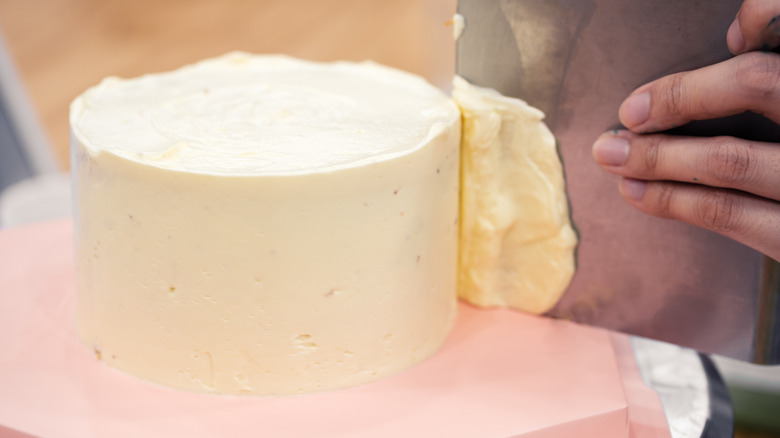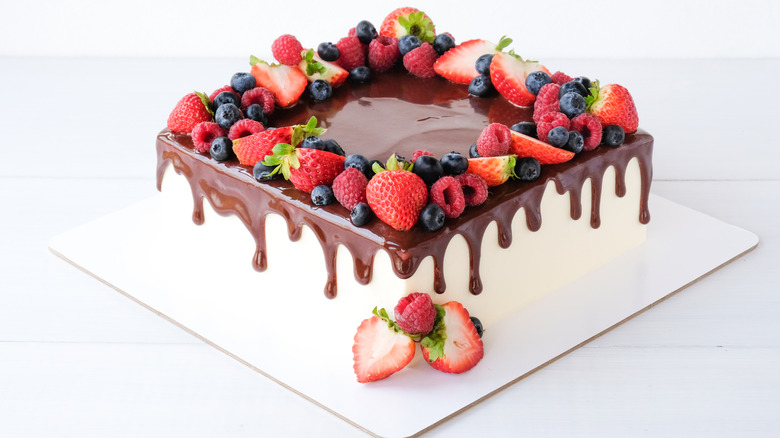How Are You Meant To Use An Acrylic Cake Disk?
Cake just tastes better when it's perfectly pretty. There's something about even, smooth frosting with sharp corners that just can't be beat. The problem is that cakes — like humans — are imperfect. We have trouble with creating straight lines by eye, and it can be especially difficult when they're made of cake. Together, it's a recipe for messy, imperfect lines and a less-than-perfect cake. That's where an acrylic cake disk comes in handy.
An acrylic cake disk is a tool to help you achieve those perfect cake lines. It acts as a guide to help you maintain not only crisp corners when frosting your cake but also to help you evenly coat the cake in the frosting. It's like a three-dimensional stencil for frosting thickness. After applying a crumb coat and freezing the cake, you frost the top of the cake and apply a round of parchment paper. Then, you choose a cake stencil a little larger than the cake, depending on the thickness of frosting you want, such as ⅛ or ¼ of an inch, and place it on top of the frosting. For a truly perfect cake, you can take a level and double-check your work.
After this, add frosting to the sides of the cake. Then, using an icing scraper with the cake disk as a guide, you smooth and scrape the sides of the cake to be even with the cake disk. Once you've finished scraping, remove the disk and parchment. Touch up the top, and you have a perfectly frosted cake.
Tips for perfecting cake disk decorating
The process is easy with the right tools: Two disks, one or two pieces of parchment, one cake board, which helps move the cake off the bottom cake disk, an icing scraper, an offset spatula — or a wide piping bag like Coty Beth's cake design TikTok channel shows — and a turning cake base or stand. It might also help to know what frosting mistakes to avoid.
Using two disks maintains an even thickness all the way from the top to the bottom. The scraper will sit flush against both disks, not tilting in or out. You need to take the time to make sure the disks are perfectly aligned on the cake, or you'll have a leaning tower look. Once it's lined up, you're good to go. Some bakers decorate upside down, claiming it gives sharper corners — perhaps a holdover from pre-disk days — others decorate right side up to avoid the stress of a flip.
Once you're done, chill the cake to firm up the frosting, and the top acrylic disk comes off easily with a thin palette knife warmed with water. The parchment does two things: It helps the disk stay in place with a little dollop of frosting, and it helps the disk release without dragging a large offset all the way around the cake. This stops it from messing up and gauging the nice, even, sharp cake corners you just spent all that time working for.
@cotybeth.cakedesign sharp edges with a @thecakesafeco acrylic disk 🔪 #frostedcake #cakefrosting #buttercream #satisfying #cakedecorator #frostingcake
Which cake disk do you need?
The benefit of a cake disk made from acrylic is that it's see-through, so you can see what you're doing as you're doing it; it's also reusable and easy to clean. Acrylic is a type of plexiglass. It's transparent like glass, but it's lighter and more durable like plastic, and it is food-safe. Icing scrapers can also be purchased in acrylic, which will help you see behind them as you scrape, but you could also use a bench scraper, offset spatula, or opaque cake scraper if that's what you have.
Cake disks come in many different shapes and sizes, and you should choose a round based on the thickness of icing you want in your final cake versus the diameter of your baked cake. An 8-inch cake with an ¼ inch frosting thickness will use an 8.25-inch disk. However, you will need to measure your cake to see how much it shrinks during baking; a cake baked in an 8-inch round tin that shrinks by a half inch but is decorated with an 8.25-inch disk will have ¾ inch of frosting all around before decorating. That's a lot of frosting, but no judgment if that's what you're going for.
The most common cake disks will be round, but they come in all kinds of shapes: Square, hexagonal, heart-shaped, and even scalloped. The simpler the shape, the easier it will be to learn to use.


